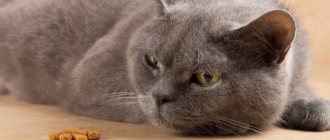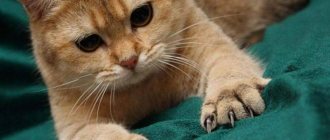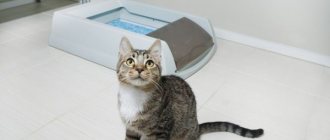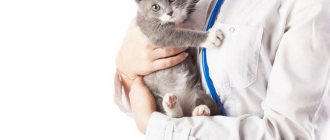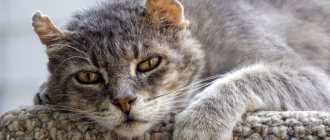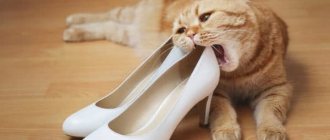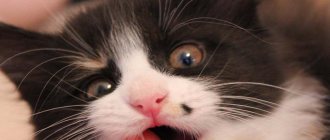Tail diseases in cats
Pets tend to get sick. Many symptoms indicate that the cat has sores on its tail. The owner must notice them in time and provide the necessary assistance, contact a veterinarian, because sometimes this can lead to the development of complex and dangerous diseases.
Disease on a pet's tail can occur for various reasons. Often these are: long-standing injuries, severe bruises, wounds, fractures or any other damage. Sometimes, but there are still diseases that are quite difficult to determine. These include: tumors, unknown neoplasms, eczema, osteomyelitis. Any of them requires high-quality qualified treatment in compliance with all requirements and recommendations of a veterinarian. Every loving owner should know why such diseases occur and how to deal with them.
Common diseases
Vertebral caries. The main cause of the disease is a lack of calcium, which occurs as a result of impaired metabolism. If you feel a cat's tail, you can feel formations on it; they resemble beads strung on a thread. If left untreated, the tail will completely lose its mobility, stop bending, and the pet will feel discomfort all the time.
Osteomyelitis is a disease that is caused by inflammatory processes in the bone marrow of the tail. This leads to serious injuries and infectious diseases. The most important symptoms are: lameness of the cat, pain when pressing the tail, lack of appetite. Sometimes, the presence of purulent ulcers may indicate that a sore has appeared.
Tail hair loss
The following symptoms symbolize this problem::
- the presence of bald spots;
- on the upper part of the tail, at its base, the hair has become greasy, greasy and constantly rolls down;
- Under the fur you can find a discharge that is oily and brown in color.
The cause of tail baldness may be a disruption in the functioning and functionality of the glands that produce fat. If fat production is disrupted, then the above changes occur, the skin balance is disrupted and the pet suffers.
More often, ulcers occur in short-haired four-legged friends. They can appear along the entire length of the tail, often affecting the root, and this can cause necrosis of the tissues and vertebrae of the tail.
An ulcer on the tail requires serious treatment and attention from the owner. If a crust has formed on it, then it must be removed from there and the wound must be cleaned of suppuration. Be sure to treat everything with an antiseptic for cats. Also, it is worth treating it with ointment (Vishnevsky, streptomycin) and applying a bandage.
In advanced cases, the cat may develop gangrene, blood poisoning and serious consequences.
Various neoplasms
If you find a tubercle on the tail and a cat, then you should contact a veterinarian as soon as possible.
It could be:
- malignant tumor;
- bag of pus;
- accumulation of parasites.
The pet needs a thorough examination, diagnosis and treatment.
Fluffies that lead a very active lifestyle quite often receive fractures, dislocations and other damage to their tail. In such cases, after x-rays, splints, casts and hard bandages are applied. After a certain time, they are removed, the injury heals and the cat returns to its usual rhythm of life.
Once you get a cat, you need to monitor its health and fulfill all the conditions necessary for it. If you find small sores on your cat's tail or baldness of any size, you should visit a doctor. Self-medication should not be done, it can only aggravate the situation and develop complications of the disease.
How to stop the habit
You can stop your cat from sucking its tail in the following ways::
- Offer your fluffy a “tail substitute.” You can use a toy or choose another thing that is safe for your pet.
- Using bitter-tasting solutions (not poisonous!). This approach is recommended if the animal is harming its furry cane. By licking the bitter solution, the cat will eventually wean itself from chewing its tail. But there is another problem: the pet can become irritable and even aggressive. The owner needs to be attentive to his four-legged friend during this period. Deprived of its usual joy, a cat needs additional portions of affection, especially before bed. During these minutes, the owner must help the pet calm down and fall asleep without a “pacifier.”
Source
Treatment
Providing first aid to a pet in a timely manner can save its life. If there is a fracture, the cat should be placed at rest and carefully transported in a carrier, taken to a veterinarian. After the examination, an x-ray is taken and the necessary medications are prescribed. In some cases, a cast is applied.
If scratches and wounds occur or hair loss occurs in the tail area, sulfur ointment is used, which is sold at any pharmacy. It does not dry out the skin and promotes rapid healing.
The most common problem in domestic cats is worms. Anti-inflammatory agents and a proper diet with the addition of vitamins can help remove them, which will not only have a beneficial effect on health, but will make the coat smooth and silky.
Opinion of zoopsychologists
A cat, no matter how long it is next to a person, remains at heart a predator driven by hunting instincts. When a little kitten plays with his tail, he learns to track, chase, and catch nimble little furry prey. Chasing the tail is the first step to successful mouse hunting. The baby catches the tail of his mother and his brothers and sisters with equal enthusiasm.
A kitten is born with instincts “written” in its genes. He plays in order to:
- study;
- hone the skills of a hunter;
- improve mentally and physically;
- maintain physical fitness.
Desire to hunt and play. In conditions of limited space, domestic cats cannot realize the hunting instinct and exchange the missing object for an analogue (according to the cat's understanding). After all, the fluffy moving tail looks so much like a mouse.
Animal psychologists consider this behavior to be the norm in kittens. In adult cats, chasing their own tail is also a favorable sign. Only a calm cat happy with its life has the desire to play.
Owner actions.
If the owner is concerned about the cat's desire to chase its tail, it is worth taking care of the toys.
The animal needs to play, and there is only one object at its disposal - its tail. By buying a pet a fur mouse, a ball or a feather tassel and spending time playing with the pet, the owner will not only keep him busy. Researchers say that playing together strengthens the psycho-emotional bond between humans and pets.
Cats play to chase each other's tail
Another reason why an animal has the habit of chasing and biting its tail is that it is simply playing
. Consider that they are generally calm and usually sleep many hours a day, so from time to time, at the moment when they want to be activated, they may start playing with anything: fluff, paper and even their own tail.
In this case, you don't need to deprive him because he only wants to play. Although you can pay more attention and play with him so as not to hurt him.
Reasons for sucking
The main factor that prompts a cat to bite its tail is an unsatisfied sucking reflex. It occurs as a result of improper weaning of the kitten from the cat. Most often, young cats that are abandoned by their mother or, for some reason, were separated from her before the due time, suck the tip of their tail . The optimal period for distributing kittens is considered to be 12 weeks. Babies weaned from their mother at an earlier age can often be seen sucking their tail. Usually this phenomenon goes away after a few months and ends in about a year. But in some cases, the “sucking” habit remains with the animal for life.
© shutterstock
Diagnosis and treatment
After discovering lost hair, it is necessary to urgently show your pet to a veterinarian, since at home there is no way to understand the cause of the disease. To make a diagnosis, the veterinarian will carry out the following procedures: collect anamnesis (interview the owner about past diseases, nutrition); conduct an external examination for the presence of characteristic symptoms; will take blood and skin scrapings for study. If necessary, ultrasound diagnostics are performed. After determining the cause of alopecia, the doctor prescribes treatment recommendations:
- Fleas. Elimination of parasites is carried out using shampoos (Fitoelita, Lugovoy, Celandine), drops on the withers (Stronghold, Advocate, Bars), sprays (Delix, Frontline). For prevention, it is recommended to wear a flea collar.
- Lichen. Treatment is usually local - shampoos (Doctor, Alezan, Antifungal), ointments (Yam, Sanderm), Fungin is effective. Vaccines are common for treatment and prevention - Polivac, Vakderm.
- Avitaminosis. If the animal is fed natural products, it is recommended to add a vitamin complex. It is better to give pregnant cats special food designed for this condition. Sometimes doctors prescribe sulfur preparations and immunostimulants.
- Hormonal imbalances, dermatitis, stress - specific treatment depending on the identified problem.
- Inflammation of the paraanal glands. Treatment – massaging the anus area from the outside or inside, treatment with an antiseptic through a catheter. If necessary, antibiotics and rectal suppositories are prescribed to relieve inflammation.
- Allergy. The irritant is eliminated and antihistamines are given.
If your cat's tail comes off, then the best method of preventing this symptom is prevention. It is enough to provide adequate feeding and care, regular examinations and monitoring of the pet’s condition.
How to treat?
Constant licking of fur down to the epidermis is not normal and requires therapeutic measures. It is impossible to eliminate the problem without finding out its original source. To do this, contact a veterinarian who will conduct a diagnosis and select medications if necessary. Drug treatment is required for atopic dermatitis. To eliminate itching, the following medications are prescribed for cats:
When a pet licks its fur to the skin under the influence of stress factors, the cat needs to be provided with peace and surrounded with care. If pathological licking occurs against the background of an allergic reaction, then the influence of the irritant on the cat’s body is immediately excluded. If the violation does not go away, then additional antihistamines are prescribed. To combat the problem caused by small parasites, pet hair is treated. For this purpose, you can use antiparasitic drops, tablets or sprays.
Attract attention
It is also possible that the animal has this behavior because it is jealous
the arrival of a new person in the house. Cats are very territorial and don't take change well, so if a child arrives or sees a new animal in your home, it's best to spend some time introducing yourself and letting your cat get used to this new presence.
In this sense, the animal will bite its tail only to attract attention
. Although they are very independent, the truth is that they place great importance on love and want to feel loved. Therefore, if they feel that you are paying attention to other members, they may act in this peculiar way.
Announcements on NN.RU - Home
Synology 210j 2-disk network drive Number of HDD spaces: 2 Maximum volume: 12TB (2x6TB) Form factor of HDD spaces. Price: 5,000 rub.
radio components reception. Microcircuits capacitors, transistors, connectors, switches, lamellas, etc. expensive. Price: 50,000 rub.
Travel to any area of the city is free, we work even on holidays. We will repair any TV and provide a guarantee of up to 20 months. Fast and... Price: 500 rub.
Professional repair of any TVs (LCD, plasma, projection, picture tube) Thomson, Samsung, LG, Rolsen, Rubin, Philips. Price: 500 rub.
The cat itches and chews itself
If a cat is actively itching and biting into its own body, it is bothered by itching. Itching occurs when pain receptors are irritated. We can say that itching is pain of low intensity. And pain is a sign of ill health that should not be ignored.
Is it normal for a cat to itch?
If an animal licks itself or itches after sleep, this is quite normal. The cat is just tidying up. After the cat has eaten deliciously, she begins to actively lick herself. This is sometimes not liked by owners who feed their animals natural food. Because, having licked itself and combed itself, the animal actively smells of the food it just ate.
It is especially unpleasant if a curious animal looks into the trash can. Sometimes cats can pull out the remains of herring or other fish and eat them. And then lick yourself thoroughly. After this, the cat will actively smell of fish for some time.
If the cat itches constantly and licks itself until its hair falls out, you need to take your pet to the clinic to rule out serious diseases.
Signs of a pathological condition of an animal
The itching may be skin-related or your cat may have itchy ears. In the latter case, the animal will scratch not only the auricle, but also try to put its paw into the ear canal and scratch the place that bothers it.
In addition to the fact that the animal is actively itching and gnawing at itself, as if trying to gnaw something out from under the skin, an attentive owner may notice:
- deterioration of the animal's fur and its loss;
- the pet's plaintive meowing when trying to scratch itself;
- red spots, rashes, excoriation (scratching) and ulcers on the skin;
- dandruff, scab, oily scales;
- excrement of parasites and the parasites themselves;
- constant licking of paws;
- scratching and biting one's own skin.
If the owner discovers something similar in his pet, he should take him to the veterinary clinic. As long as the changes are small, it is quite easy to help the animal. As the process progresses, it will take much more time and effort to heal your pet.
Causes of the phenomenon
The most common reason that an animal bites into its own rump is flea bites. In this case, you need to rid your pet of annoying insects as soon as possible.
[1]
Ear mite parasitism leads to severe itching in the auricle. The animal tries to bury its hind paw deeply and scratches the auricle. It rubs its head against pieces of furniture and shakes it, as if trying to shake something out of its ear. In addition, the owner may notice an unpleasant odor from the animal’s ear, discharge of a brown substrate, and hearing impairment. With otitis (inflammation of the ear in a cat), the symptoms will be approximately the same. When trying to scratch its ear, the cat may meow pitifully.
When a cat's skin is parasitized by a lice-eater mite, the animal's hair deteriorates and falls out. The skin is very itchy, the animal scratches the skin vigorously, and crusts appear on it. The waste products of parasitic insects are found in the wool.
Sarcoptic mange is a parasitic disease caused by mites that burrow into the deep layers of the skin. At the initial stage, sarcoptic mange is asymptomatic. Its main symptom is frequent scratching of the animal. Then redness appears on the skin. As the disease develops, quickly bursting blisters appear on the animal’s face and near the ears. The itching at this time is very strong, the animal actively itches, spreading parasites throughout the body. The skin in the affected area dries and becomes bald. Deep wounds appear on the animal's tail and paws, oozing ichor.
Notoedrosis, or cat scabies, is another tick-borne infection. It manifests itself as severe itching. The first signs of this disease are loss of hair around the cat's ears and very severe itching in this area. Soon the ticks “settle” in the animal’s abdomen, perhaps moving from the muzzle while the animal sleeps, curled up in a ball. The fur on the animal's belly falls out, the skin thickens, becomes covered with pustules and scabs. The cat constantly licks and scratches the affected areas. Demodectic mange and cheyletiellosis cause similar symptoms.
Pyoderma, fungal infections, and autoimmune diseases lead to the appearance of various rash elements on the animal’s skin (vesicles, pustules, scabs, ulcers, erosions) and severe itching.
Hormonal imbalances can lead to itching and the appearance of a brown scab on the animal's tail and croup area.
Intestinal diseases or helminth infections in severe cases also cause severe itching. But, in addition to the fact that the cat is itching, the owner may notice a deterioration in her mood, a decrease in appetite and stool disorders. And sometimes vomiting.
Allergies are one of the most common reasons that cause a cat to actively scratch, scratching the skin.
Sometimes the cat itches a lot, but he doesn’t have any fleas or infections, and he doesn’t suffer from allergies. In this case, the itching may be psychogenic. As a result of stress, a cat may lose its fur, combing it out in clumps.
Effective treatment without identifying the root cause is impossible. Therefore, the animal will still have to be taken to the veterinarian. At home, the owner can monitor the cleanliness of the animal’s skin and fur, scrupulously follow the veterinarian’s instructions, and provide the pet with balanced and high-quality nutrition and attention.
The cat licks his wounds
Group: Participants Messages: 43 Registration: 1/19/2012 Tails: 2 City Nakhodka (Primorsky Territory) User No.: 18166
Thank you said: 14 times
Sister's cat, help me figure this out.
1. Boy, 1.5 years old, 5.5 kg 2. Neutered 3. No vaccinations 4. Date of last deworming was September 15, they don’t remember the name of the drug, suspension 5. Royal Canin is hypoallergenic for more than a month. Previously, heals for castrati. He drinks enough water from the tap. Urination is normal, stable, once a day, stools are of normal consistency, formed, not dry, once a day. 6. The temperature is normal, it never rose 7. At the beginning of October, the flea collar was removed (they were worn in the spring for prevention, there were no fleas) and after 3-4 days the cat began to lick the skin until there were bleeding wounds in the area of the knees and left thigh. We went to the veterinary clinic, where they assumed that he had injured himself and told him to treat him with fucorcin. We treated and observed the cat for about a week, but the reasons for this injury were not found. The cat continued to lick the wounds and they increased in size. Licked wounds also began to appear on the front paws. We went to a veterinary clinic again, this time to a different one. They assumed it was flea dermatitis (although no fleas were visible, they live on the 4th floor), they told me to treat the fleas and put on a new collar. We bought the drug “Dana”, but for puppies (the pet store did not have the drug for cats, they said that the cat is large and can be used for puppies) and dropped a couple of drops on the withers according to the instructions for weight. The cat immediately began trying to lick the drug. But he couldn't reach it. The cat was restless for days, did not sleep at night, woke up the owners, and kept trying to lick off the drug. A day later, he was washed with regular cat shampoo to wash off the drug, because the cat’s reaction was clearly abnormal. He became noticeably calmer, but now he tried to scratch the place where the drug was and fur began to come out there. The skin in this area began to get wet. The cat combed this place with its paw, all the fur came out in a patch. The skin was constantly wet and irritated in this area. We went to the doctor again. They said that the drug could not be used for puppies and that you just had to wait for it to heal, not let it be licked, and treat it with peroxide. At this time there were also wounds on the paws, but apparently they bothered the cat less. After the treatments, the wound began to dry out and a crust had already formed, but after a few days the cat scratched it until it bled again. Then they sewed a blanket for him so that he could not comb his hair. After about a week, the wound healed. There were wounds on the legs all this time, they did not heal completely, the cat constantly licked them a little. We went back to the doctor at the clinic. They wanted to scrape it, but since the wounds were dry, the doctor said there was no point. They gave him a collar to prevent the cat from licking the wounds and prescribed a “Stop Itching” course. After that, after about a week, everything had practically healed and the cat’s collar was removed. While the owners were at work, the cat again licked his knees to the point of bleeding wounds. We went to the doctor again. They told me to switch to hypoallergenic food and told me to wear a collar again. Switching to a new food did not make things better. the small bag of food ran out, we bought exactly the same food, but in another store and the cat began to go to the toilet loosely for about 4 days, everything returned to normal on its own, the food was not changed. But my skin didn’t get any better. The cat has learned to lick its paws and collar. They made him a jumpsuit. Nothing helped, I still licked it both in the collar and in the overalls. We went to get tested again to the doctor. On the same visit, the cat was given the first injection of Otodectin, because parasites were suspected. Based on the test results, the doctor said that there was inflammation and some kind of allergic reaction. After 10 days, they injected 2 injections of “otodectin”. And they prescribed “stop stress”. But it doesn't get any better. In general, the cat is active and his appetite is normal. Only sad when they wear overalls. But even in a collar he already behaves actively if without clothes. The owner notes a wave-like flow, at times the wounds dry out, then again he licks them more actively. Treatment has no effect on this. It turned out to be a lot of text, but it all lasts so long and we just give up ((((What else can we guess. And the veterinarians have already gone through everything in our small town ((( 8. Test results (norms, unfortunately, are not indicated) hemoglobin 123 red blood cells 5.8 ESR 4 Leukocytes 11.6 Basophils 2 (increased) Eosinophils 12 young 0 rods 8 segments 43 lymphocytes 28 monocytes 7 (increased) Basophilia, monocidosis 9. Prescribed drugs indicating dosages, frequency and method of administration “Stop- itching” took a course according to the instructions “Otodectin” 2 subcutaneous injections in the withers area with an interval of 10 days “Stop-stress” is now taken according to the instructions, 3 drops in the morning and 3 drops in the evening (they have already been taking it for 10 days, there is no effect)
Physical problems
Veterinarians focus on the health status of the pet if its behavior is a symptom of disease. The reason for chasing your own tail can be pain, itching, burning caused by:
- parasitic diseases – worms, fleas, ticks;
- inflammation of the paraanal glands;
- anal herbs;
- constipation;
- skin diseases;
- allergies to food;
- tail injuries - fracture, bites of other animals, compression, torn ligaments;
- mental disorders, for example, the consequences of brain injuries and infections.
Trying to get rid of painful sensations, the cat diligently licks and chews its tail, until bald spots and wounds form.
It is necessary to pay attention to such behavior in a timely manner.
Also watch the video why a cat chases its tail:

